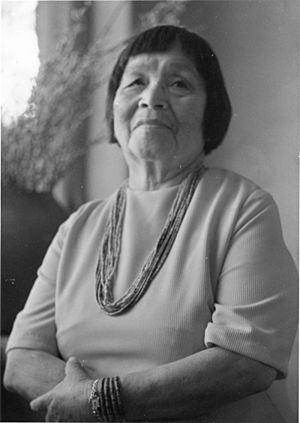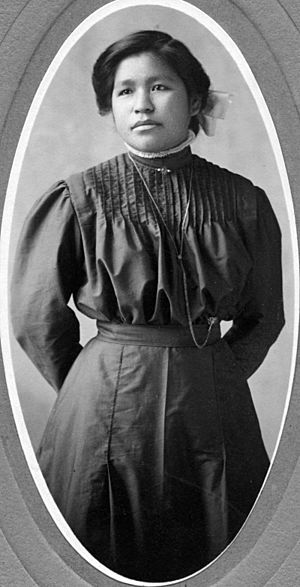Polingaysi Qöyawayma facts for kids
Quick facts for kids
Polingaysi Qöyawayma
|
|
|---|---|

c. 1970
|
|
| Born | 1892 Oraibi, Hopi Reservation, Arizona
|
| Died | (aged 98) Phoenix, Arizona
|
| Burial place | Kykotsmovi Village Cemetery |
| Other names | Elizabeth Q. White |
| Alma mater | Bethel College |
| Occupation |
|
|
Notable work
|
The Sun Girl, No Turning Back |
| Spouse(s) | Lloyd White (m. 1931, div. c. 1933) |
| Relatives | Al Qöyawayma (nephew) |
Polingaysi Qöyawayma (1892 – December 6, 1990), also known as Elizabeth Q. White, was a talented Hopi woman. She was known as a teacher, writer, and potter.
Contents
About Polingaysi Qöyawayma
Polingaysi Qöyawayma was born in 1892 in Oraibi. This village is located on the Hopi Reservation in Arizona. Her parents were Fred and Sevenka. Her Hopi name means "butterfly sitting among the flowers in the breeze."
Her father worked for a Mennonite missionary named Henry Voth. Mr. Voth built a school in Oraibi. He tried to teach Christianity to the Hopi people. Some villagers did not like his methods. This caused disagreements among the Hopi people.
Early Life and Education
In 1906, Polingaysi went to the Sherman Institute in Riverside, California. She lived with a teacher's family for four years. There, she learned English and became a Christian.
When she returned to Oraibi, it was hard for her to fit back in. The villagers felt she had adopted too many "white people's ways." They were not open to her Christian teachings.
She then moved to Newton, Kansas, to live with a Mennonite family. She also studied at Bethel College to become a missionary. In 1919, she worked as a substitute teacher in Tuba City. She also attended the Los Angeles Bible Institute.
However, she started to have doubts about being a missionary. She found it hard to convert anyone in Oraibi. She wanted to combine the best parts of Hopi traditions with the best parts of white culture. She believed in keeping the good from all sources.
Teaching Career and Philosophy
In 1924, Polingaysi Qöyawayma started working at the Indian school in Hotevilla. She began as a housekeeper and later became a teacher. She used a special teaching method. She taught students in their native Hopi first. Then, she would switch to English. This is called bilingual education.
This method caused some problems with other teachers. Some parents also preferred their children to learn only English customs. They thought this would help their children succeed in American society. But Polingaysi believed that Native American students learned better. She felt they understood new ideas when they were linked to traditional stories and legends.
In 1925, she became a government employee. She continued teaching in Hopi and Navajo schools until 1954. She shared her teaching ideas, saying:
I tell young people this: Find the best things in your own culture and keep them. They are most important in your life. But also take the best from other cultures and mix it with what you have. Don't limit yourself. If you want more education, go for it without fear. You have the strength to keep going. Use it.
Her teaching methods eventually became well-known and praised. In 1941, the Bureau of Indian Affairs chose her. She traveled across the country to show other school officials how to teach bilingually.
In 1974, Polingaysi helped start a scholarship fund. This fund was for Hopi students at Northern Arizona University. It was later renamed the Elizabeth White Hopi Scholarship in her honor.
Writing Journey
Polingaysi Qöyawayma was also a writer. In 1941, she wrote a novel called The Sun Girl: A True Story about Dawamana. This book is about a young Hopi girl facing tough choices.
Her own life story, No Turning Back, was published in 1964. She told her story to author Vada F. Carlson. A famous literary critic, Robert Kirsch, called it "one of the rare and important documents of the Indian experience." He said it showed the meeting of two different cultures.
She also co-wrote another book with Vada F. Carlson in 1985. It was called Broken Pattern: Sunlight & Shadows of Hopi History.
Art of Pottery
After she retired from teaching, Polingaysi focused on music and art. She especially loved pottery. She created a unique style of pottery. She used pink clay and added raised symbols. These symbols included corn and Kokopelli figures.
The Heard Museum in Phoenix showed her work in the late 1970s. Some of her pots are still part of their permanent collection. She often welcomed students who studied cultures to her home. Famous writers like Ernest Hemingway also visited her.
Personal Life and Legacy
Polingaysi Qöyawayma married Lloyd White in 1931. He was part-Cherokee. They divorced a year or two later.
Her nephew, Al Qöyawayma, is also a very successful potter and sculptor.
Polingaysi stayed healthy into her eighties. She had a stroke in 1981. She passed away in a nursing home in Phoenix in 1990, at the age of 98. She was buried at the Kykotsmovi Village Cemetery.
Awards and Recognition
Polingaysi Qöyawayma received many awards for her work and contributions:
- Department of the Interior Distinguished Service Award (1954)
- Bronze sculpture by Una Hanbury for the Museum of Northern Arizona (1976)
- Arizona Indian Living Treasure Award (1978)
- Heard Museum Gold Medal (1978)
- Bethel College Outstanding Alumna (1979)
- Bullock's "Be Beautiful" Award (1984)
- Arizona Author Award for The Sun Girl (1989)
- Inducted into the Arizona Women's Hall of Fame (1991)


